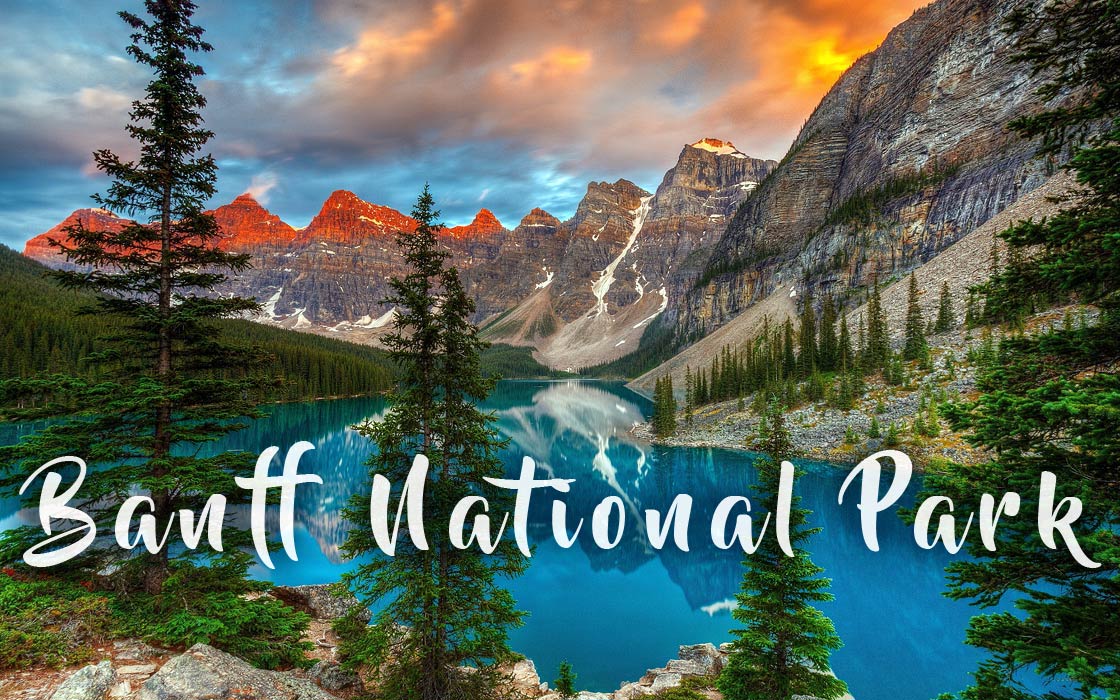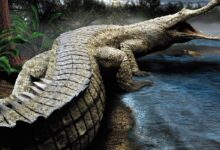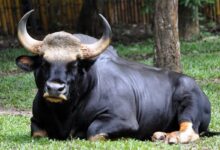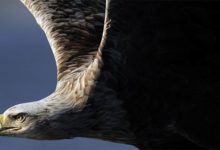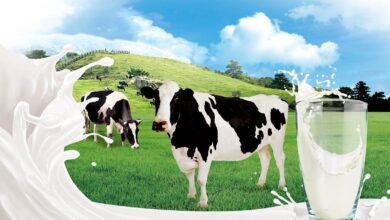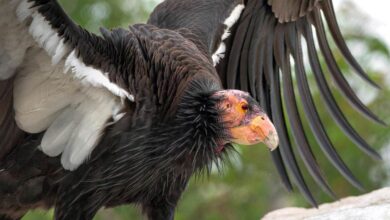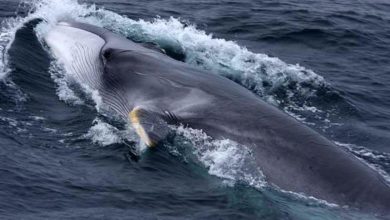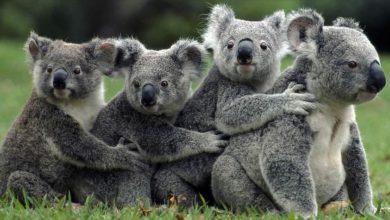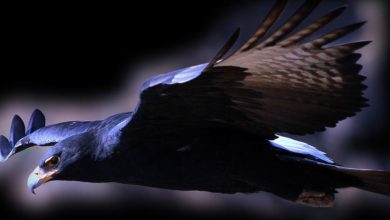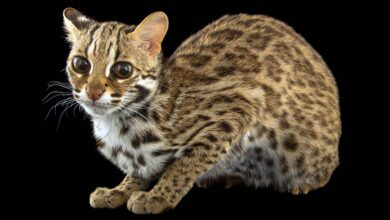Banff National Park – Canada’s oldest national park
Nestled in the heart of the Canadian Rockies, Banff National Park is a breathtaking wilderness wonderland, a true natural gem that has captivated visitors for over a century. From its glittering glaciers and turquoise lakes to its towering mountains and pristine forests, Banff is a landscape of pure beauty and breathtaking majesty, a place where visitors can escape the hustle and bustle of modern life and immerse themselves in the raw, untamed grandeur of the natural world. Whether you’re looking to hike its scenic trails, relax in its luxurious hot springs, or simply take in its stunning vistas, Banff National Park is an unforgettable destination that will leave you enchanted and inspired for a lifetime.
Banff National Park is a national park located in the Canadian Rockies in Alberta, Canada. It is Canada’s oldest national park, established in 1885. The park encompasses over 6,641 square kilometres (2,564 sq mi) of mountains, glaciers, forests, meadows, and rivers. It is home to a diverse array of wildlife, including grizzly bears, wolves, elk, and bighorn sheep. The park also features hot springs, such as the famous Banff Upper Hot Springs, as well as scenic drives and hiking trails. The town of Banff, located within the park boundaries, offers accommodations and amenities for visitors.
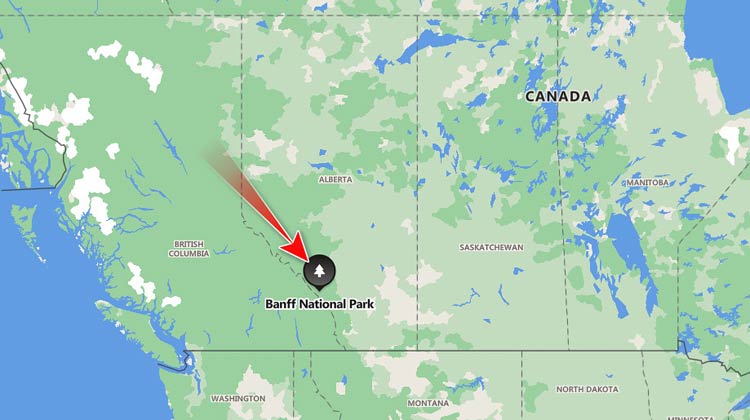
Location
Banff National Park is located in the Canadian Rockies in Alberta, Canada. Specifically, it is situated in the western part of Alberta, about 128 km (80 mi) west of Calgary and 58 km (36 mi) east of Lake Louise. The park is easily accessible by car and by public transportation from both Calgary and Edmonton.
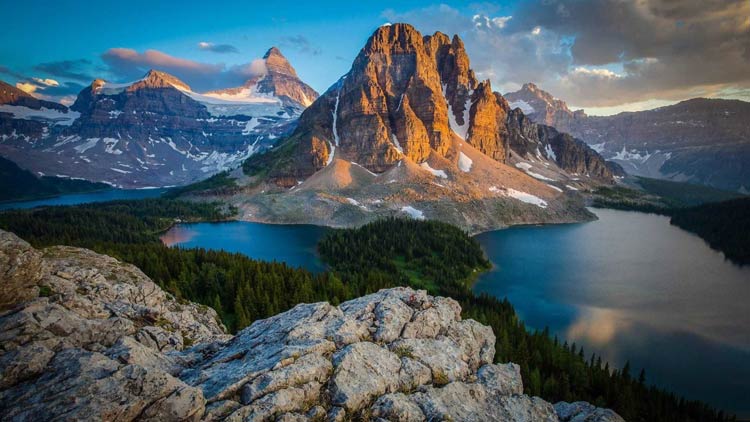
Basic Facts About Banff National
- Location
Banff National Park is located in the province of Alberta, Canada, and is part of the Canadian Rocky Mountains. - Size
Banff National Park covers an area of 6,641 square kilometers (2,564 square miles). - Establishment: Banff National Park was established on November 26, 1885, making it Canada’s first national park.
- Elevation
The park’s elevation ranges from 1,400 meters (4,593 feet) to 3,954 meters (12,972 feet) above sea level. - Climate
Banff National Park has a subalpine climate, with warm summers and cold winters. - Natural resources
The park is home to a diverse range of natural resources, including glaciers, hot springs, lakes, rivers, and forests. - Wildlife
Banff National Park is home to many species of wildlife, including elk, bighorn sheep, mountain goats, and grizzly bears. - Recreational opportunities
Banff National Park offers a wide range of recreational opportunities, including hiking, camping, fishing, skiing, and snowboarding. - Tourism
Banff National Park is a popular tourist destination, attracting millions of visitors each year. - Conservation
Conservation is a top priority in Banff National Park, and the park is working to protect its natural resources for future generations.
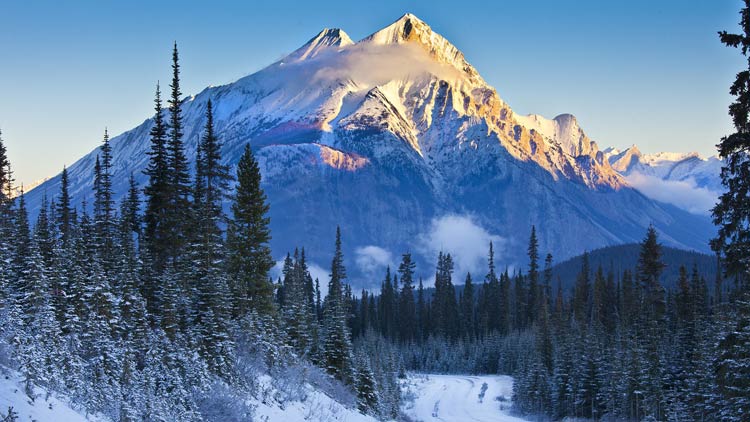
History and name of the Park
Banff National Park was established in 1885, making it Canada’s first national park. The park was created in response to the growing interest in the Canadian Rockies during the late 19th century. The Canadian government set aside land for the park in order to preserve the area’s natural beauty and make it accessible for public enjoyment.
The park was named after the Town of Banff, which was named in 1884 by George Stephen, the President of the Canadian Pacific Railway, after Banffshire, Scotland, the birthplace of two of his business partners.
The park’s creation sparked the establishment of the national park system in Canada and the creation of many other national parks across the country. Today, Banff National Park is a UNESCO World Heritage Site and one of Canada’s most popular tourist destinations, attracting millions of visitors each year.
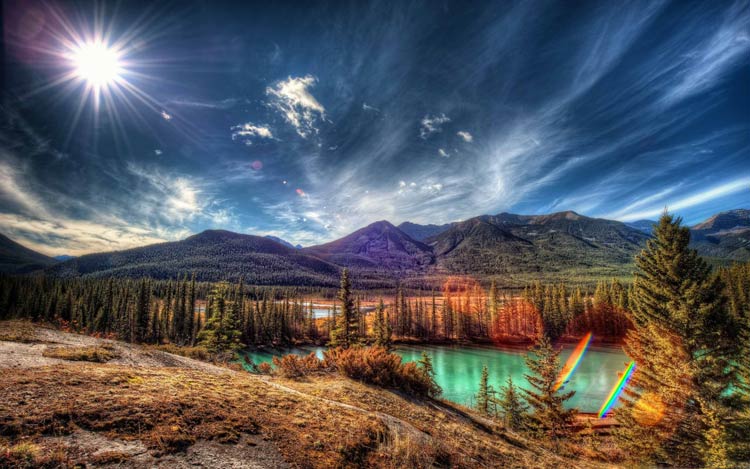
Geography
Banff National Park is located in the Canadian Rockies, which is a part of the Rocky Mountains range. The park encompasses over 6,600 square kilometers of diverse terrain, including rugged mountains, glaciers, valleys, forests, meadows and rivers. The park is located within the Alberta Rocky Mountains and borders with Kootenay National Park in British Columbia, Yoho National Park in British Columbia and Jasper National Park in Alberta.
The park’s highest peak is Mount Assiniboine at an elevation of 3,618 m (11,870 ft). Other notable peaks in the park include Mount Louis (3,326 m / 10,913 ft), Mount Temple (3,543 m / 11,624 ft) and Mount Rundle (2,949 m / 9,675 ft). The Bow River, which runs through the park, is a popular spot for fly fishing and rafting.
The park is home to a diverse array of plant and animal life, including grizzly bears, wolves, elk, bighorn sheep, and many species of birds and fish. The park’s forests are predominantly made up of Lodgepole Pine, Engelmann Spruce, and Subalpine Fir, while the alpine and subalpine areas are characterized by rocky terrain and glaciers.
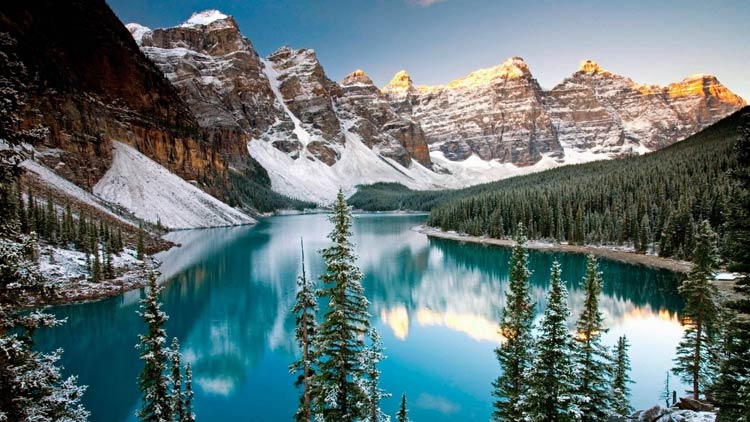
Glaciers and ice fields, and hot springs
Banff National Park is home to several glaciers and ice fields, including the Columbia Icefield which is one of the largest ice fields in the Rocky Mountains. The Columbia Icefield is located on the boundary of Banff and Jasper National Parks and covers an area of about 325 square kilometers. The ice field is home to eight major glaciers, including the Athabasca Glacier which is one of the most accessible glaciers in North America. Visitors can take a tour on the glacier by bus or take a guided hike on the glacier.
The park also features several hot springs, including the famous Banff Upper Hot Springs. The hot springs are located in the mountains and are fed by natural hot water that rises from the earth. The hot springs are a popular spot for visitors to relax and soak in the warm waters. Other hot springs in the park include the Cave and Basin National Historic Site, which is the birthplace of the national park system in Canada, and the Miette Hot Springs in Jasper National Park.
Overall, the glaciers and hot springs are some of the most striking and unique features of Banff National Park, and visitors can enjoy a wide range of activities related to these natural wonders, from short walks to guided tours, and even snowcoach trips on the glacier.
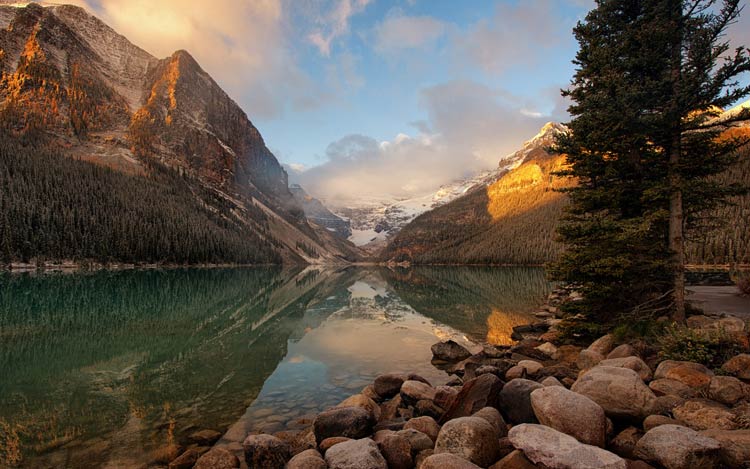
Banff
The Town of Banff, located within the boundaries of Banff National Park, is the main commercial center in the park and serves as a hub for visitors. It is a popular tourist destination and offers a wide range of accommodations, from hotels and resorts to campgrounds and hostels. The town also has a variety of shops, restaurants, and bars catering to visitors.
In addition to being a commercial center, Banff is also a center for cultural activities. The Banff Centre, located in the town, is a leading arts and cultural institution that hosts a wide range of performances, exhibitions, and workshops. The Banff Centre Mountain Film and Book Festival, held annually in October, is a popular event that features films, lectures, and readings about mountain culture and adventure.
The Park also offers several museums, such as the Cave and Basin National Historic Site, which tells the story of the hot springs and the birth of the national park system in Canada. The Whyte Museum of the Canadian Rockies is also located in the town, which showcases the art and history of the Canadian Rockies through exhibitions, special events, and educational programs.
Overall, the Town of Banff offers visitors a chance to enjoy the natural beauty of the park while also experiencing the cultural activities and amenities of a small town.
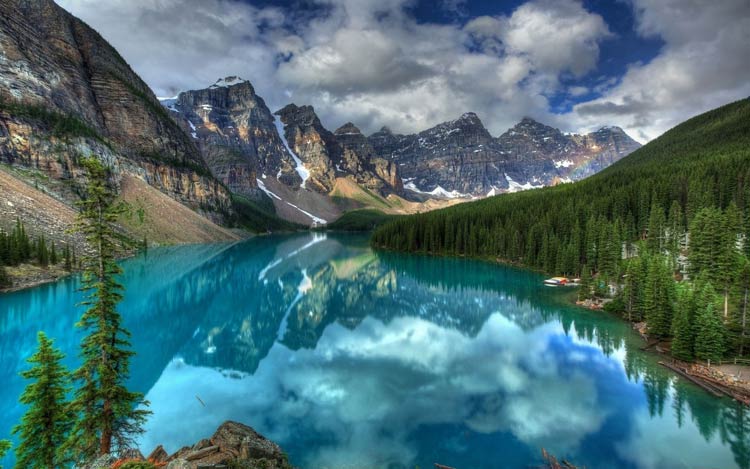
Lake Louise
Lake Louise is a glacial lake located in Banff National Park, in the Canadian Rockies of Alberta, Canada. The lake is known for its stunning turquoise color and the dramatic mountain scenery that surrounds it. The lake is fed by the Lefroy Glacier and the Victoria Glacier, which are located in the nearby mountains.
Lake Louise is a popular destination for tourists and outdoor enthusiasts. Visitors can take a stroll along the lake’s shore, go canoeing on the lake, or hike in the surrounding mountains. The lake is also a popular spot for photography, with many visitors coming to capture the beautiful scenery.
One of the most popular hikes in the area is the Plain of Six Glaciers Trail, which takes hikers on a scenic trail that winds along the shores of Lake Louise and offers views of six glaciers. The lake is also home to the famous Fairmont Chateau Lake Louise, a luxury hotel that offers guests a chance to stay in a beautiful mountain setting.
Lake Louise Ski Resort, located just a short drive from the lake, is also a popular destination for skiing and snowboarding in the winter.
Overall, Lake Louise is a must-see destination for visitors to Banff National Park, offering a chance to experience the natural beauty of the Canadian Rockies and enjoy a wide range of outdoor activities.

Icefields Parkway
The Icefields Parkway, also known as Highway 93, is a scenic highway that runs for 230 km (143 mi) through the Canadian Rockies, connecting the towns of Jasper and Lake Louise in Alberta, Canada. The highway winds its way through Banff and Jasper National Parks, offering visitors breathtaking views of the Rocky Mountains, glaciers, rivers, waterfalls, and alpine meadows.
The Icefields Parkway is considered one of the most scenic drives in the world and is a popular destination for tourists, photographers, and outdoor enthusiasts. Along the route, there are several viewpoints, rest areas, and hiking trails that offer visitors the opportunity to explore the natural beauty of the Canadian Rockies.
The most notable attraction on the Icefields Parkway is the Columbia Icefield, which is one of the largest ice fields in the Rocky Mountains. Visitors can take a tour on the glacier by bus or take a guided hike on the glacier. Other highlights along the route include the Athabasca Falls, Peyto Lake, and the Crowfoot Glacier.
The best time to drive the Icefields Parkway is from June to September when the weather is warmer and the road is open. However, the road is also open in the winter and offers a unique opportunity to see the Canadian Rockies in a different light and visitors can also enjoy winter activities such as cross-country skiing, snowshoeing and Ice climbing.
Overall, the Icefields Parkway is a must-see destination for visitors to Banff and Jasper National Parks, offering a chance to experience the natural beauty of the Canadian Rockies and enjoy a wide range of outdoor activities.

Moraine Lake
Moraine Lake is a glacially-fed lake located in the Valley of the Ten Peaks, in Banff National Park, Alberta, Canada. The lake is known for its stunning turquoise color and the dramatic mountain scenery that surrounds it. The lake is surrounded by a rock pile called a moraine, which gives the lake its name.
Moraine Lake is a popular destination for tourists and outdoor enthusiasts. Visitors can take a stroll along the lake’s shore, go canoeing on the lake, or hike in the surrounding mountains. The lake is also a popular spot for photography, with many visitors coming to capture the beautiful scenery.
One of the most popular hikes in the area is the Larch Valley-Sentinel Pass Trail, which takes hikers on a scenic trail that winds through a larch forest and offers views of the Ten Peaks and Moraine Lake.
The best time to visit Moraine Lake is from June to September when the weather is warmer and the road to the lake is open. However, the lake is also beautiful in the early morning and evening light, when the sky is painted with soft colors.
Overall, Moraine Lake is a must-see destination for visitors to Banff National Park, offering a chance to experience the natural beauty of the Canadian Rockies and enjoy a wide range of outdoor activities.
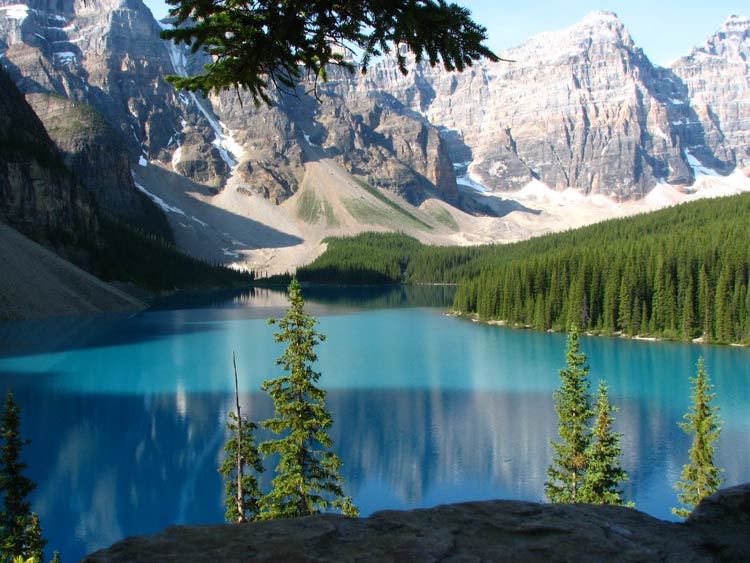
Geology of Banff National Park
Banff National Park, located in the Canadian Rockies of Alberta, Canada, is known for its stunning geological features, including mountains, glaciers, hot springs, and valleys. The park is part of the Canadian Rocky Mountain Parks UNESCO World Heritage Site and is considered one of the most geologically diverse national parks in Canada.
The geology of Banff National Park is characterized by the presence of ancient rocks, some dating back as far as 1.8 billion years. These rocks have been shaped and sculpted over time by the forces of erosion, glaciation, and tectonic activity. The park is home to some of the oldest rocks in the Canadian Rockies, including the 1.8 billion-year-old gneiss and schist found in the Mount Forbes area.
The park is also home to several mountain ranges, including the Front Ranges, the Main Ranges, and the Vermilion Ranges. These ranges are composed of sedimentary rocks such as limestone and sandstone, which have been uplifted and folded due to tectonic activity. The peaks and valleys of these ranges offer visitors stunning views of the Canadian Rockies.
The park is also home to several glaciers and ice fields, including the Columbia Icefield, the largest ice field in the Rocky Mountains. These glaciers and ice fields are remnants of the last ice age and are slowly shrinking due to climate change.
Finally, the park is also known for its hot springs, including the famous hot springs at Banff, which are a result of the area’s geothermal activity. The hot springs are heated by geothermal water that has been heated by the Earth’s crust and are a popular destination for visitors looking to relax and soak in the warm waters.
Overall, the geology of Banff National Park is diverse and offers visitors a chance to see a wide range of geological features, from ancient rocks to glaciers and hot springs, all shaped by the forces of nature.

Climate
Banff National Park, located in the Canadian Rockies of Alberta, Canada, has a subarctic climate, characterized by long, cold winters and short, mild summers.
During the winter months, from November to April, the park experiences heavy snowfall and temperatures can drop well below freezing, with an average temperature of -16°C (3°F). This makes it a popular destination for winter sports such as skiing, snowboarding, and snowshoeing.
Summer months, from May to October, are milder, with temperatures averaging around 15°C (59°F) during the day. During this time, the park is popular for hiking, camping, and other outdoor activities. However, it’s important to note that temperatures can fluctuate widely in the park, especially at higher elevations and in the evenings, so visitors should be prepared for a wide range of weather conditions.
Precipitation is relatively low in the park, with an average of around 400 mm (15.7 inches) per year, and is distributed throughout the year. Snowfall is heavy in the winter, but it may fall as rain during the summer months.
Overall, the climate of Banff National Park can be challenging, especially during the winter months, but visitors who come prepared for the conditions can enjoy a wide range of outdoor activities and take in the stunning scenery of the Canadian Rockies.
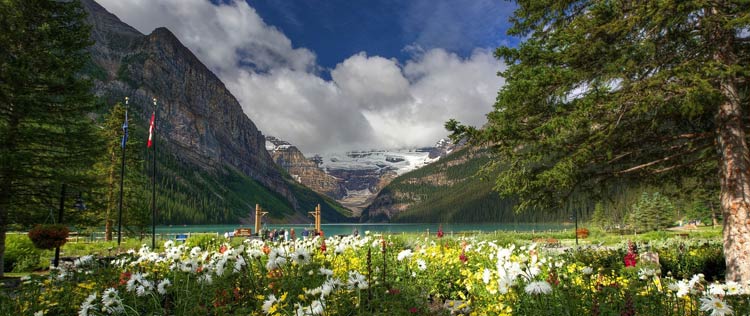
Flora in Banff National Park
Banff National Park, located in the Canadian Rockies of Alberta, Canada, is home to a diverse range of flora, including both alpine and subalpine species.
At lower elevations, visitors can find coniferous forests composed mainly of Lodgepole Pine, Engelmann Spruce, Subalpine Fir, and Douglas-fir. These trees provide habitat for a variety of wildlife, such as bears, elk, and moose.
As elevation increases, the forests give way to subalpine meadows and alpine tundra. These areas are characterized by low-growing shrubs, wildflowers, and grasses. Some of the most common species found in these areas include heather, lupine, fireweed, and alpine forget-me-nots.
The park is also home to many wetlands, including marshes, bogs, and fens, which support a variety of plant species such as mosses, sedges, and cotton grass.
In the park, there are also a number of rare and endangered species of plants, such as the Banff Springs snail and the western mountain avens.
The best time to see the wildflowers in the park is during the summer months, from June to September, when the wildflowers are in full bloom.
Overall, the flora in Banff National Park is diverse and provides visitors with the opportunity to see a wide range of plant species, from coniferous forests to alpine tundra and subalpine meadows, each unique and beautiful in its own way.
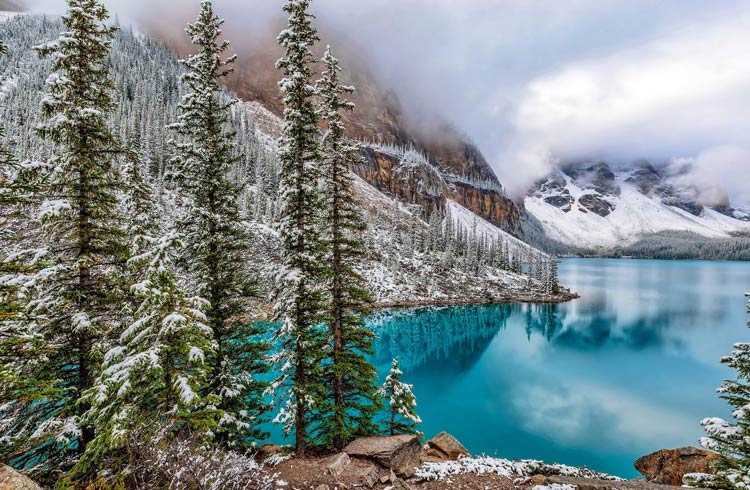
Fauna in Banff National Park
Banff National Park, located in the Canadian Rockies of Alberta, Canada, is home to a diverse range of fauna. The park’s varied habitats, including forests, meadows, wetlands, and alpine areas, support a wide variety of wildlife.
- Some of the most commonly seen mammals in the park include elk, bighorn sheep, mountain goats, moose, black bears, and grizzly bears. The park is also home to a small population of wolves and cougars, but they are less commonly seen by visitors.
- The park is also home to a wide variety of bird species, including the golden eagle, the great horned owl, and the Clark’s nutcracker.
- In the rivers and lakes of the park, visitors can find fish species such as cutthroat trout, bull trout, and mountain whitefish.
- During the summer months, visitors can also see many species of insects, including butterflies and dragonflies.
- The park is also home to a number of rare and endangered species, such as the woodland caribou, the grizzly bear, and the Canada lynx.
It’s important to note that visitors should always be aware of the park’s wildlife and take necessary precautions to avoid dangerous encounters.
The fauna in Banff National Park is diverse and provides visitors with the opportunity to see a wide range of wildlife species in their natural habitats.
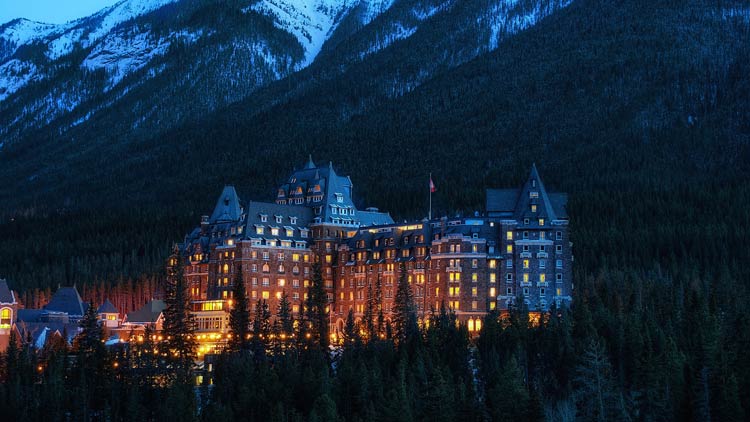
Tourism and tourist attractions in the park
Banff National Park, located in the Canadian Rockies of Alberta, Canada, is a popular tourist destination known for its stunning scenery, outdoor recreational opportunities, and cultural activities.
Some of the most popular tourist attractions in the park
- The hot springs
The park is home to three natural hot springs, including the Banff Upper Hot Springs, the Miette Hot Springs, and the Radium Hot Springs. Visitors can soak in the hot springs and enjoy the beautiful mountain views. - Lake Louise
This iconic lake is known for its turquoise-green water and the Victoria Glacier in the background. Visitors can hike around the lake, rent a canoe, or take a horse-drawn carriage ride. - Moraine Lake
Moraine Lake is another iconic lake in the park, known for its stunning blue-green water and the Valley of the Ten Peaks. Visitors can hike the surrounding trails, rent a canoe, or take a guided rock climb. - The Icefields Parkway
This scenic drive runs through the park and offers visitors the chance to see some of the most spectacular mountain scenery in the Canadian Rockies, including glaciers, waterfalls, and alpine landscapes. - Skiing and snowboarding
During the winter months, visitors can enjoy a variety of ski and snowboard runs at the park’s three ski resorts, including Mt. Norquay, Lake Louise Ski Resort, and Mt. Banff. - Hiking and camping
The park offers visitors a wide range of hiking trails, from easy nature walks to strenuous backcountry treks. The park also has a number of campgrounds for visitors who want to spend the night. - Wildlife viewing
The park is home to a wide variety of wildlife and visitors can see them in their natural habitats, including bears, elk, bighorn sheep, mountain goats, moose, and many species of birds.
Banff National Park offers visitors a wide range of activities and attractions, from soaking in hot springs and hiking to skiing and wildlife viewing, making it a popular destination for tourists from around the world.

How To Reach To Banff National Park?
Banff National Park is located in the Canadian Rockies in the province of Alberta, Canada. There are several ways to reach the park, including:
- By Air
The closest international airport to Banff National Park is the Calgary International Airport, which is located about 140 km (87 miles) from the park. From the airport, visitors can rent a car or take a shuttle bus to reach the park. - By Car
Banff National Park can be reached by car from several major cities in western Canada and the United States, including Calgary, Vancouver, and Seattle. The park is accessible via the Trans-Canada Highway and several other major roads. - By Bus
There are several shuttle bus companies that offer services to Banff National Park from major cities in western Canada and the United States. These bus services are convenient for visitors who do not have their own transportation. - By Train
The park can also be reached by train via the Rocky Mountaineer, which offers scenic rail tours through the Canadian Rockies.
Regardless of the mode of transportation, visitors to Banff National Park will be treated to breathtaking scenery as they make their way to this unique and iconic destination.
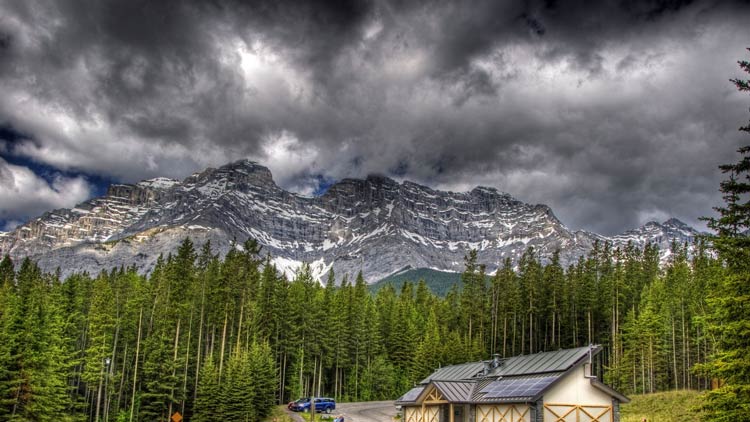
Best Time To Visit Banff National Park
The best time to visit Banff National Park depends on the type of experience you are looking for. Here are a few considerations to help you plan your trip:
- Summer
June to August is the busiest time of year in Banff National Park, with warm temperatures and long daylight hours. This is the best time for hiking, camping, and other outdoor activities. - Winter
November to April is the winter season in Banff National Park, and this is when the park transforms into a winter wonderland with snow-covered mountains, frozen lakes, and abundant wildlife. Winter is the best time for skiing, snowboarding, and other winter sports. - Spring and Fall
May and September are considered shoulder seasons in Banff National Park, and this is when the park experiences more moderate temperatures and fewer crowds. Spring and fall are great times for photography, birdwatching, and exploring the park’s scenic drives.
It is important to note that the weather in Banff National Park can be unpredictable, so it’s always a good idea to check the forecast and be prepared for changing conditions. Regardless of when you visit, Banff National Park is a year-round destination that offers breathtaking scenery, abundant wildlife, and a range of recreational opportunities.

Conservation
Conservation is a key aspect of Banff National Park, as it is one of the oldest and most well-known national parks in Canada. The park is home to a diverse range of plant and animal species, and preserving this unique ecosystem is a top priority. Here are a few ways that Banff National Park is working to conserve its natural resources:
- Habitat protection
Banff National Park protects and manages large areas of land to maintain healthy habitats for wildlife and plant species. This includes the preservation of key migration routes and breeding grounds, as well as the control of invasive species. - Wildlife management
The park’s wildlife management program works to maintain healthy populations of species such as elk, bighorn sheep, and grizzly bears. This includes monitoring and controlling the populations of predators and prey, and protecting sensitive habitats. - Water management
Banff National Park is home to many important watersheds, and preserving the quality and quantity of the park’s water resources is critical. This includes managing water levels in the park’s lakes and rivers, and controlling erosion and sedimentation. - Air quality management
Banff National Park is also working to protect its air quality, as air pollution can have a significant impact on the park’s natural resources and human health. This includes reducing emissions from park facilities and vehicles, and educating visitors about the importance of air quality.
These are just a few examples of the many conservation initiatives underway in Banff National Park. By working to protect its natural resources, Banff National Park is helping to ensure that this unique and breathtaking destination will be preserved for generations to come.

Banff National Park in numbers
Banff National Park is a vast and diverse wilderness area that has captured the hearts and imaginations of visitors for over a century. Here are some statistics about the park:
- Size
Banff National Park covers an area of 6,641 square kilometers (2,564 square miles) making it the largest national park in the Canadian Rockies. - Elevation
The park ranges in elevation from 1,400 meters (4,593 feet) to over 3,000 meters (9,843 feet) above sea level. - Visitors
Banff National Park attracts millions of visitors each year, making it one of Canada’s most popular tourist destinations. In 2019, the park received over 4 million visitors. - Wildlife
Banff National Park is home to over 60 species of mammals, including elk, deer, bears, and wolves. The park is also home to over 200 species of birds and numerous species of fish, reptiles, and amphibians. - Glaciers
The park is home to several glaciers, including the Columbia Icefield, which is the largest ice field in the Canadian Rockies. - Lakes
Banff National Park is home to numerous lakes, including the famous Lake Louise, which is known for its stunning turquoise waters and scenic surroundings. - Hot springs
Banff National Park is home to several hot springs, including the Banff Upper Hot Springs, which is the park’s oldest tourist attraction. - Trails
The park offers over 1,000 kilometers (621 miles) of trails for hiking, biking, and horseback riding. - Campgrounds
Banff National Park has over 2,500 camping spots available for visitors, including backcountry campsites and frontcountry campgrounds.
These statistics provide a glimpse into the impressive scale and diversity of Banff National Park, and highlight why it is one of Canada’s most treasured natural areas.

Interesting facts about Banff National Park
- Banff National Park is Canada’s oldest national park, established in 1885.
- Banff National Park is part of the Canadian Rocky Mountain Parks UNESCO World Heritage Site, which includes six national parks in Canada and one in the United States.
- The park is located in the Rocky Mountains of Alberta, Canada, and spans 6,641 square kilometers (2,564 square miles).
- The park is named after the Town of Banff, which was established in the park in 1883.
- The park’s hot springs were a major factor in the creation of the park and have been a popular tourist attraction for over a century.
- The park is home to a number of glaciers, including the Columbia Icefield, which is the largest icefield in the Rocky Mountains.
- The park is home to a wide variety of wildlife, including elk, bighorn sheep, mountain goats, moose, black bears, and grizzly bears.
- The park is a popular destination for outdoor activities such as hiking, camping, skiing, and wildlife viewing.
- The park is also home to the historic Banff Springs Hotel, which was built in 1888 and is a National Historic Site of Canada.
- The park is also home to the Cave and Basin National Historic Site, which is the birthplace of Canada’s national parks system.
- The park is a very popular tourist destination, with over 4 million visitors annually.
Banff National Park is a unique and historic place, with a diverse landscape and rich wildlife, that draws millions of visitors from around the world each year.
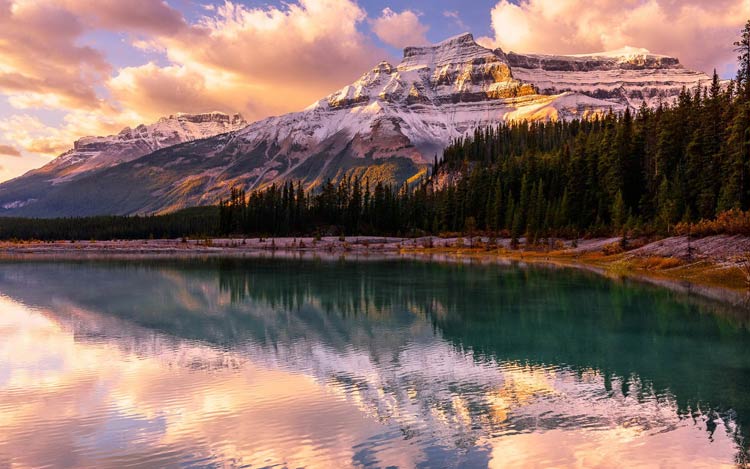
Q&A (questions and answers) about Banff National Park
Q: What is Banff National Park?
A: Banff National Park is Canada’s oldest national park, established in 1885. It is located in the Rocky Mountains of Alberta, Canada, and spans 6,641 square kilometers (2,564 square miles). The park is known for its stunning scenery, outdoor recreational opportunities, and cultural activities.
Q: What are some popular tourist attractions in the park?
A: Some popular tourist attractions in Banff National Park include the hot springs, Lake Louise, Moraine Lake, the Icefields Parkway, skiing and snowboarding, hiking and camping, and wildlife viewing.
Q: How did Banff National Park get its name?
A: Banff National Park is named after the Town of Banff, which was established in the park in 1883.
Q: What kind of wildlife can be found in the park?
A: Banff National Park is home to a wide variety of wildlife, including elk, bighorn sheep, mountain goats, moose, black bears, and grizzly bears.
Q: What kind of outdoor activities can be done in the park?
A: Visitors to Banff National Park can enjoy a variety of outdoor activities, including hiking, camping, skiing, and wildlife viewing.
Q: How many visitors does the park get each year?
A: Banff National Park is a very popular tourist destination, with over 4 million visitors annually.
Q: Is there any historical site inside the park?
A: Yes, the park is home to the historic Banff Springs Hotel, which was built in 1888 and is a National Historic Site of Canada, and the Cave and Basin National Historic Site, which is the birthplace of Canada’s national parks system.
Q: Is Banff National Park part of any UNESCO World Heritage Site?
A: Yes, Banff National Park is part of the Canadian Rocky Mountain Parks UNESCO World Heritage Site, which includes six national parks in Canada and one in the United States.


